Electric vehicles (EVs), battery technology firms, and lithium miners have made significant strides in global adoption, technological innovation, and production capacity since first emerging in the late 2010s and early 2020s. But despite this progress, the sectors have faced substantial headwinds in recent years, with profitability challenges weighing on investor returns.
Now, 2025 is shaping up as a potential turning point. With stronger fundamentals and more mature market dynamics than half a decade ago, the EV value chain may be gearing up for a “second ride” – one that could reward investors who stay the course or are ready to get back on board.
Key Takeaways
- Intense Research & Development (R&D) efforts by Western automakers to reorient supply chains & production processes, alongside fierce competition in the Chinese EV market, have led to margin compression, weighing on profitability and investor returns.
- Despite the profitability crunch, the EV industry has delivered strong revenue growth. This leaves room for earnings upside if consensus analyst expectations for margin recovery materialise.
- Lithium producers may have reached a turning point, as persistent oversupply has finally triggered production cuts and supply pauses from several Chinese miners – opening the door for a rebound in global lithium prices and sentiment.
The Cost of Evolution
There comes a point in every new technology’s “hype cycle” when investors stop reaching for their wallets and start asking tougher questions. Enthusiasm gives way to scepticism, and one question rises above all else: “How much money are you actually making?”
Over the past two years, the EV industry had faced that question with increasing regularity – and the answer has often fallen short. Traditional automakers in the West have made meaningful strides in shifting production and design toward electric vehicles but rising R&D costs have eaten into margins. Meanwhile, Chinese EV giants – despite their technological edge and battery expertise – contend with cutthroat competition at home and growing trade barriers abroad.
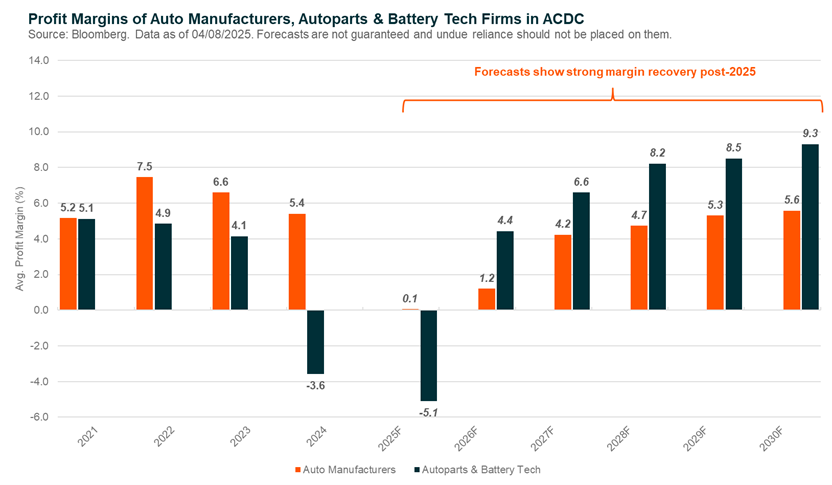
These challenges have translated into a sharp decline in profitability across the EV value chain. At the height of their momentum in 2022, global auto manufacturers, and auto parts & battery tech firms boasted profit margins of 7.5% and 4.9%, respectively. But by EOY 2025, these figures are expected to fall to just 0.1% and -5.1%. This deterioration in margins has been a key driver of weak share price performance for EV-related stocks over the past two years.
However, consensus now points to 2025 as the likely trough for industry margins. Analysts broadly expect a recovery phase to begin from 2026 onward, supported by two structural shifts:
1) Market estimates suggest that R&D spending for Western and Japanese automakers will largely peak around 2026, with little to no growth through 2030.
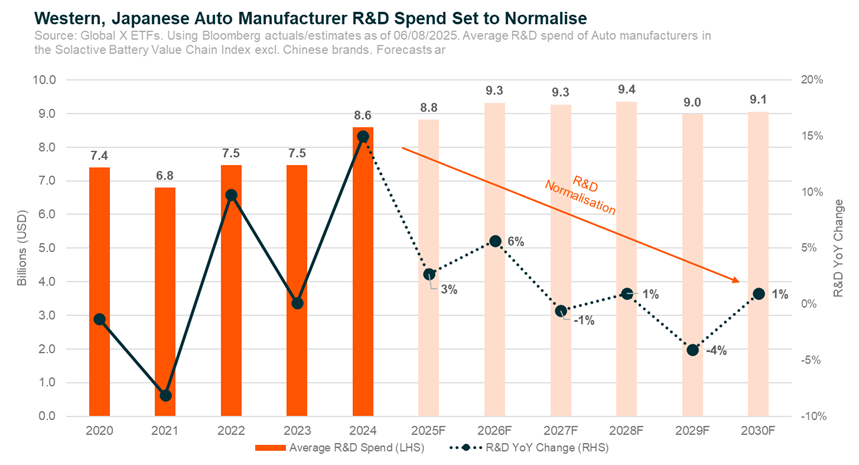
These new consensus expectations suggest the EV transition for traditional automakers is finally approaching maturity. R&D intensity is beginning to ease, and production processes are becoming more standardised and cost-efficient. This shift should enable these firms to begin scaling profitably, rather than continuing to invest heavily in transitional infrastructure.
2) In China, where EV makers have been locked in a brutal price war, state policy is expected to play a major role in stabilising margins.
As part of its broader effort to combat deflation, Beijing has launched an “anti-involution” campaign aimed at curbing excessive competition and promoting more rational, sustainable market behavior.1 These policy measures are designed to restore pricing discipline and could help bring much-needed stability to margins across the Chinese EV sector.
Below is a collection of recent headlines which underscore the Chinese government’s increasing urgency and resolve to rein in destructive competition in the EV sectors:
- May 31, 2025 - The Chinese Ministry of Industry & Information Technology called for an end to destructive price competition, warning of threats to long-term industry health. The state pledged joint enforcement with regulators to tackle below-cost sales and oversupply.2
- July 16, 2025 - Chinese Premier Li chaired a national meeting targeting “irrational competition” in the NEV sector. Officials called for regulation to restore order and stabilise margins across auto and solar stocks.3
- July 30, 2025 - The Politburo reaffirmed efforts to manage disorderly competition and excess capacity in key growth sectors – including autos and EVs – as part of a broader anti-deflation strategy.4
- August 5, 2025 - President Xi and the Politburo flagged EV price wars as a threat to growth and introduced draft legislation targeting anti-competitive pricing practices.5
If these catalysts help drive material margin recovery in both Western and Asian markets, it could mark the beginning of a major earnings expansion for the EV industry.
Furthermore, while margin recovery alone can be a powerful driver of earnings growth, the effect can be exponential when paired with strong underlying revenue momentum. Indeed, from 2020 to 2025, the aggregate revenue per share of constituents in the Global X Battery Tech & Lithium ETF (ASX: ACDC) have grown at a compound annual rate of 15% - a pace that’s roughly double that of the S&P 500.6
Investors’ focus on near-term earnings has also left large portions of the EV value chain trading at depressed revenue multiples. As of August 2025, roughly two thirds of ACDC’s constituents trade below a price-to-sales ratio of 1.5x. With a leaner cost base and margin recovery underway, this low starting point could set the stage for significant upward revisions and positive earnings surprises in the years ahead.
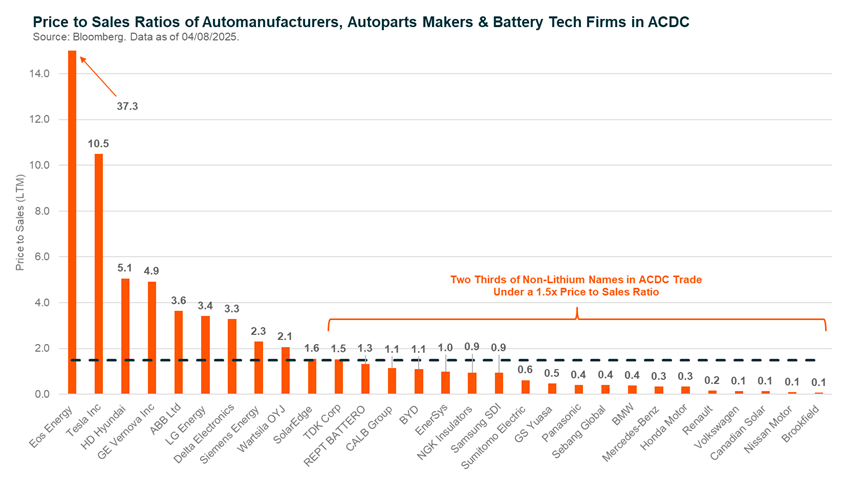
Lithium Miners Finally Hit Max Pain
Lithium spot prices and, by extension, lithium miners have struggled over the past few years in a chronically oversupplied market, largely driven by a surge in Chinese production capacity. Typically, sustained low commodity prices would trigger a reduction in supply, setting the stage for a gradual price recovery. But Chinese lithium producers have disrupted this traditional supply-cycle dynamic.
While most mining companies recognise lithium’s strategic role in the future electric economy, none have been as aggressive in pursuit of global dominance as Chinese firms. In a bid to outlast and outcompete international rivals, China’s large-scale lithium producers have embraced a “short-term pain for long-term gain” strategy.7 Despite weak prices, they’ve continued to overproduce, aiming to squeeze out less profitable or capital-constrained competitors and consolidate global market share. Observers of the crude oil market may recognise parallels with OPEC’s historic approach to defending influence through price pressure.
However, in recent weeks, we appear to have crossed the threshold of maximum pain for many of China’s over-producing lithium miners. Cracks are beginning to emerge among the country’s largest players, suggesting a potential turning point for global supply:
- Jiangxi Special Electric Motor, a vertically integrated EV parts manufacturer, recently suspended all lithium production for a month, citing cost cutting measures and system maintenance.8
- Sinomine Resources, said in June it would put its new mine developments in Jiangxi on pause as it “adjusted technology requirements”.9
Even among producers still capable of operating at current price levels, pressure is mounting. Much like in the EV sector, the Chinese government is now increasing scrutiny of lithium miners under its broader “anti-involution” campaign.
One notable example came when Zangge Mining Co., one of China’s top producers, was ordered by the Haixi local government to immediately halt all “illegal mining activities”.10
Meanwhile in Yifun, a major lithium district, eight separate miners were asked to submit reserve reports after audits found that some miners had registered false numbers to expedite licensing in 2021-22.11 Even CATL, a Chinese EV industry darling and the world’s largest EV battery producer, recently failed to receive renewed permits for lithium production at its Jiangxi mine – a huge facility which represents roughly 3% of the global lithium supply.12 These announcements have sent ripples through China’s lithium spot market, as it signalled a potential new mechanism through which the government has begun to control supply.
All these signs of emerging supply restraint have culminated in a 38% surge in Chinese lithium spodumene prices over the past month – the strongest such rally since 2022 when lithium prices were still on the rise.13
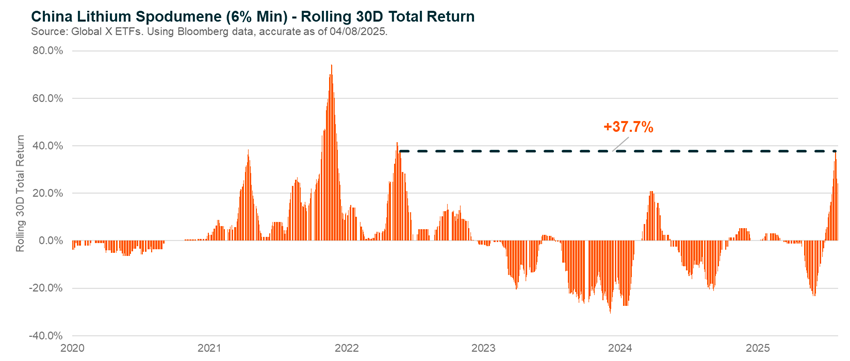

Past performance is not a reliable indicator of future performance.
Conclusion: The Second Ride Begins
After years of heavy investment, margin erosion, and investor scepticism, the EV ecosystem may finally be approaching a turning point. Across the value chain – from automakers to battery tech and lithium miners – the worst of the transition pains now appear to be behind us.
Western and Japanese automakers are beginning to benefit from years of R&D investment with spending now stabilising, production processes becoming more efficient. Meanwhile, in China, regulators are stepping in to end the EV price war and restore discipline across the supply chain through the government’s broader anti-involution campaign.
If these forces hold, and margins begin to recover atop a still-growing revenue base, the EV value chain could be on the verge of a powerful earnings resurgence.
Related Funds:
ACDC: The Global X Battery Tech & Lithium ETF (ASX: ACDC) invests in global companies developing electro-chemical storage technology and electric vehicles as well as mining companies producing battery-grade lithium.




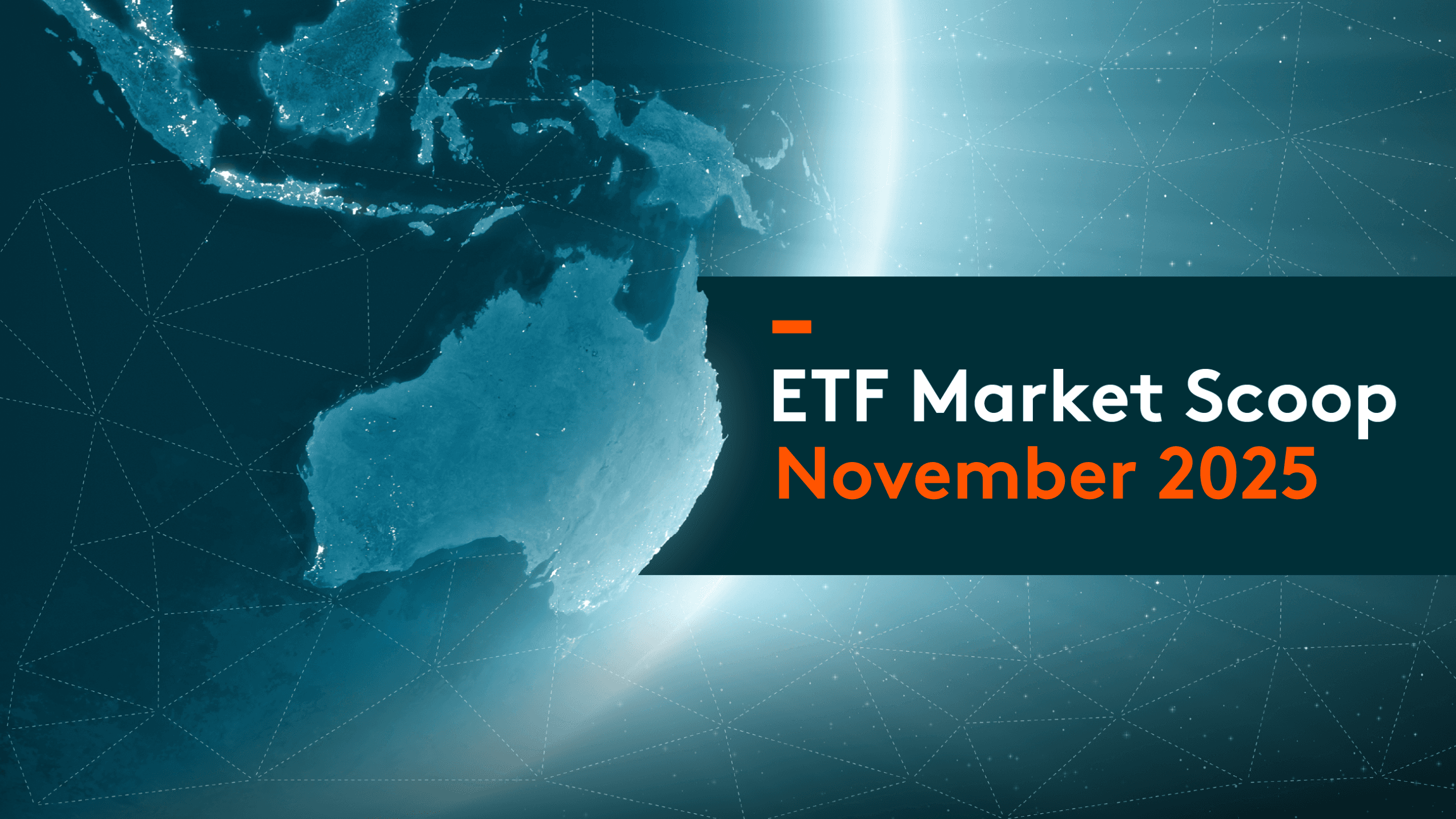

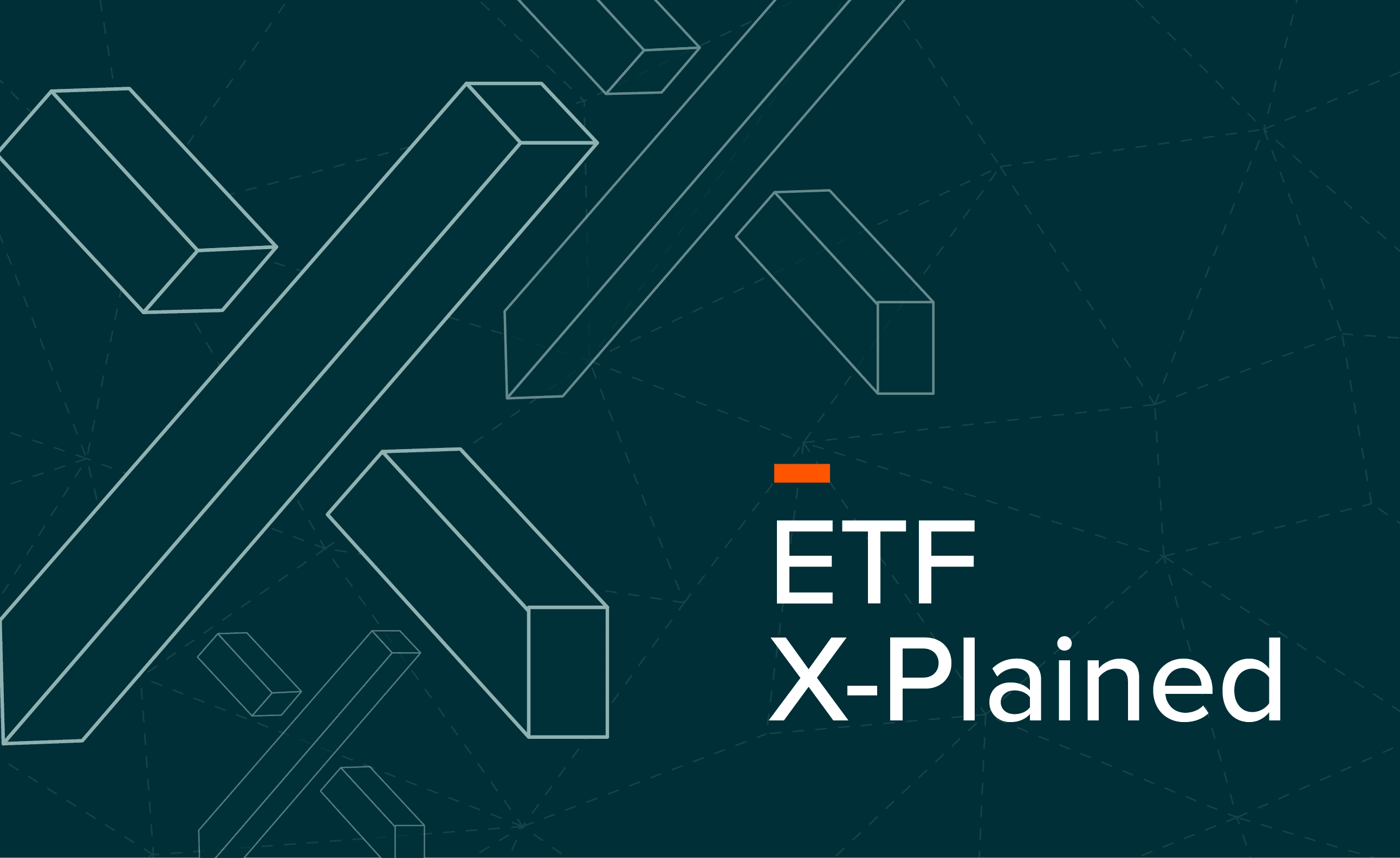





 Past performance is not a reliable indicator of future performance.
Past performance is not a reliable indicator of future performance.